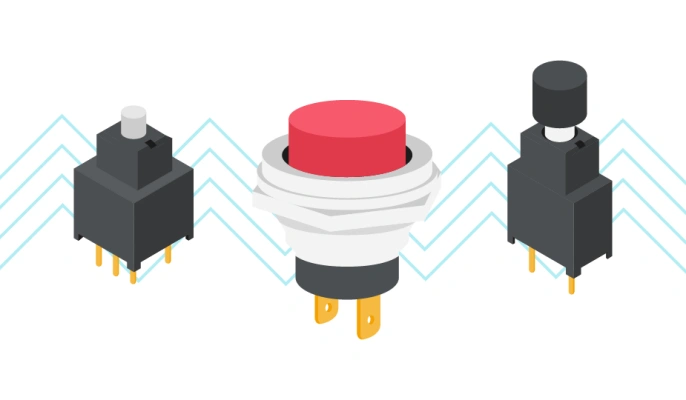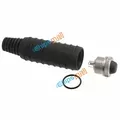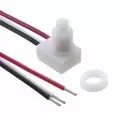OUTLINE:
Exploring Functionality: Pushbutton Switches Versus Tactile Switches
 176
176Pushbutton switches are widely used, mostly in CNC machine tools or machines with obvious functional classification. Some push button switches are made with key caps in different colors for easy identification. Other switches with more personality will add LED lights to the circuit under the key caps, and engrave different logo patterns on the key caps. Pushbutton switches with LEDs are generally called signal indicators.
In this comparative journey, we'll unravel the distinct essence of each, offering insights into their mechanics, applications, and unique traits.

Image Source: CUI Devices
What Is Meant by Pushbutton Switches
Pushbutton switches are fundamental components used in electronic circuits to control the flow of electricity.
A button is generally composed of a button cap, a reset spring, a bridge-type moving contact, a static contact, a supporting connecting rod and a shell.
Unlike toggle switches that maintain their state until manually changed, pushbutton switches are momentary, meaning they only maintain their position while pressure is applied.
When the button is pressed, it completes the circuit, allowing current to flow through. Once released, the circuit is broken, halting the flow of electricity.
These switches come in various forms, from simple momentary contact switches to more complex versions with illuminated indicators or multiple buttons.
They are commonly found in a wide range of electronic devices, such as appliances, control panels, industrial machinery, and consumer electronics, where temporary activation or control is required.
Whether it's turning on a light, activating a device, or triggering a function, pushbutton switches play a crucial role in enabling user interaction and control in electronic systems.
How Does A Pushbutton Switches Work
Pushbutton switches function by utilizing a simple mechanism to control the flow of electricity within an electronic circuit.
In their default state, these switches maintain an open circuit, with internal contacts separated. When the button is pressed, it applies force to internal components, causing the contacts to physically come into contact with each other, thus closing the circuit.
This allows electricity to flow through the switch. Once the button is released, internal springs push the contacts apart, breaking the electrical connection and returning the switch to its open state.
This momentary action makes pushbutton switches ideal for applications where temporary activation or control is required, such as in appliances, control panels, and electronic devices.
What Are the Differences between Pushbutton&Tactile Switch
Pre-introduction:what is tactile Switch like
Tactile switches, also known as tactile pushbutton switches, are a type of momentary switch that provides physical feedback to the user when activated.
Unlike standard pushbutton switches, which may not offer tactile feedback, tactile switches are designed to give the user a distinct sensation or "click" when the switch is pressed.
This tactile feedback serves as confirmation to the user that the switch has been actuated, making tactile switches particularly useful in applications where precise control or user interaction is essential.
The Differences between Pushbutton&Tactile Switch
Pushbutton switches and tactile switches are both essential components used in electronic circuits, yet they possess distinct characteristics and functionalities.
Here are the key differences between the two switches:
Tactile Feedback
Pushbutton Switches: Traditional pushbutton switches typically do not provide tactile feedback when pressed. They may offer a smooth or silent actuation, without any physical indication to the user.
Tactile Switches: Tactile switches, on the other hand, are specifically designed to provide tactile feedback. When the button is pressed, users feel a distinct sensation or "click," providing confirmation that the switch has been actuated.
User Experience
Pushbutton Switches: Due to the absence of tactile feedback, users may find it challenging to determine whether the switch has been pressed successfully, especially in applications where precise control is required.
Tactile Switches: Tactile switches enhance the user experience by providing a tactile response, which improves user interaction and ensures reliable actuation. This tactile feedback can be particularly beneficial in applications where users need to feel confident about their input.
Applications
Pushbutton Switches: Pushbutton switches are commonly used in applications where tactile feedback is not a critical requirement, such as simple on/off controls or momentary activation in electronic devices.
Tactile Switches: Tactile switches are preferred in applications where precise feedback is necessary, such as keyboards, keypads, control panels, and other interfaces where users rely on tactile cues for accurate input.
Design and Construction
Pushbutton Switches: Pushbutton switches come in various designs, including momentary and latching types, and may feature different actuator shapes and sizes. They are available in both surface-mount and through-hole configurations.
Tactile Switches: Tactile switches are engineered with specific mechanisms to provide tactile feedback, often utilizing metal dome or rubber dome constructions. They are available in a wide range of form factors and actuation forces to suit different applications and user preferences.
Can A Tactile Switch be Used Instead of a Pushbutton switch
Answer:A tactile switch can indeed be used as a substitute for a pushbutton switch in various applications.
Tactile switches provide tactile feedback, which can enhance user experience by providing confirmation of switch actuation.
They are commonly utilized in keyboards, keypads, and control panels, where users rely on tactile cues for accurate input.
When considering a replacement, it's crucial to ensure alignment of actuation force, travel characteristics, and mounting style with the application's requirements to ensure seamless integration and optimal performance.
Additionally, confirming electrical compatibility is essential to prevent any potential issues related to voltage and current ratings.
Final Verdict
In the comparison between pushbutton switches and tactile switches, both serve as essential components in electronic circuits, yet they offer distinct characteristics and functionalities.
Pushbutton switches provide simplicity and straightforward operation, while tactile switches offer tactile feedback for enhanced user interaction and reliability.
Depending on the specific requirements of the application, one may be preferred over the other.
Ultimately, understanding the nuances of each switch type empowers designers and users to make informed decisions, ensuring optimal performance and user satisfaction in electronic devices and systems.

Disclaimer: The views and opinions expressed by individual authors or forum participants on this website do not represent the views and opinions of Chipsmall, nor do they represent Chipsmall's official policy.

share this blog to:






